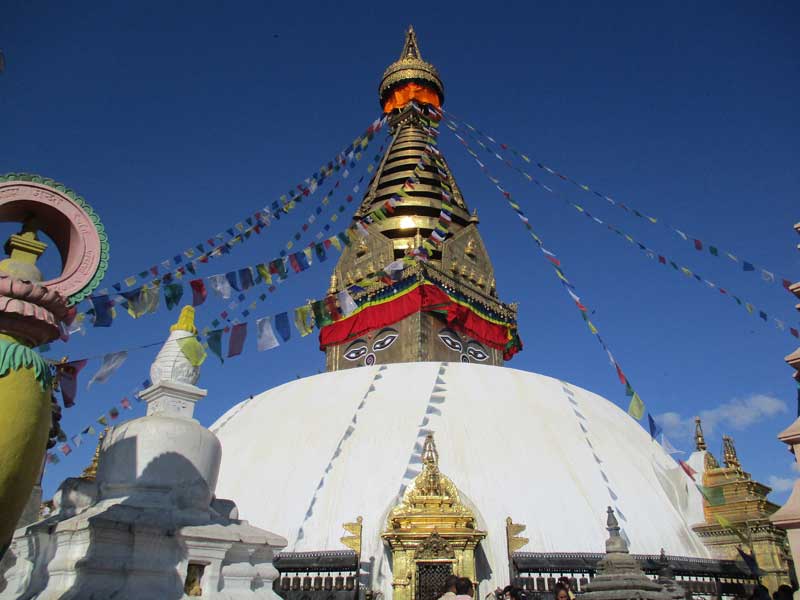According to Swayambhu Purana, once time the Kathmandu Valley was a lake. Swayambhunath is a UNESCO world heritage ancient religious architecture in the Kathmandu Valley.
- You can reach the Swayambhunath stupa from the main entrance after climbing 365 stone steps, but there are other two easy entrances also if you’re not able to walk much. Climbing through the main entrance is more fun as you’ll find a big vajra after climbing 365 steps.
- There is a history behind it, Swayambhu Purana tells Swayambhunath emerged out of a lotus flower.
The Swayambhunath stupa is believed to be 1500 years of age. - On top of Swayambhunath, there is a spire of 13 golden disks which represents the ladder to enlightenment and it was painted with 20 kg of gold during its renovation in 2010 A.D.
- Swayambhunath means self-sprung or self-risen which is derived from “Swayam” which means “self”, “bhu” means “to take birth” and “nath” means “protector or master”.
- It is also known as monkey temple but it is the wrong name. It’s name is Swayambhunath and it’s not appropriate to call it a monkey temple as it is one of the holiest Buddhist shrines. It is called a monkey temple as there are many monkeys around the temple. The name monkey temple was not given by local people. Local people never say Swayambhunath monkey temple as it doesn’t sound good.
- The main festivals celebrated at Swayambhunath are Buddha Jayanti(in April or May) and a month-long Gunla celebration (in August or September).
- The stupa has many artifacts inside it.
- Emperor Ashoka in Indian history is said to have visited the site in the 3rd century BCE. He built a temple on the hill and it was later destroyed.
- There is a popular Hindu temple dedicated to Goddess Harati which represents religious harmony among Hindus and Buddhists of Kathmandu valley.
- It is believed that at Shantipur in Swayambhunath, underground chamber there is a Tantric master Shantikar Acharya who lives from the 8th century. He has locked himself inside an underground chamber under the Shantipur temple and subsequently attained an immortal state. Here you may feel different vibes.
- Pratapur and Anantapur are the temples built by King Pratap Malla, after his victory over Tibet in the 17th century. These are found in front of the stupa with the shape of a bullet.
It is located in the west of Kathmandu and is said that the glory of Kathmandu has been started from Swayambhu. - Kathmandu Valley was covered with a lake.
- Swayambhunath is the oldest prehistoric Buddhist stupa in Nepal.
- Swayambhunath is visible for many miles and from all sides of the Kathmandu valley. It is seen peacefully during the night from the roof of any house in Kathmandu.
- A stone inscription found on Swayambhu gives evidence that by the 5th century AD, the stupa was already an important pilgrimage destination.
- You always have to walk in a clockwise direction around the stupa, with the stupa being on your right side.
- Swayambhunath stupa has many artifacts inside it.
- The place is visited by both Buddhists and Hindus, though the site is considered Buddhist.
Numerous Hindu monarch has paid their homage to the Swayambhunath which can be found in a stone inscription in the temple.
